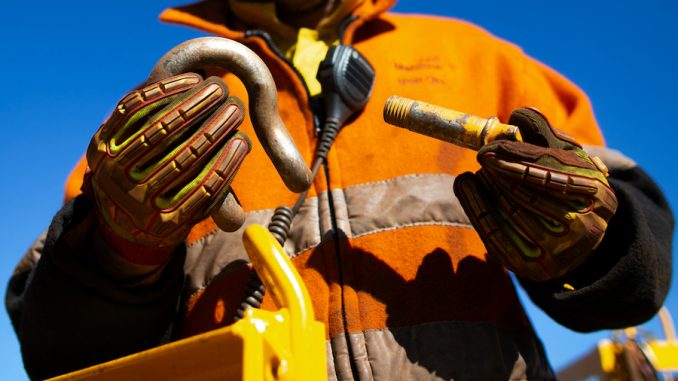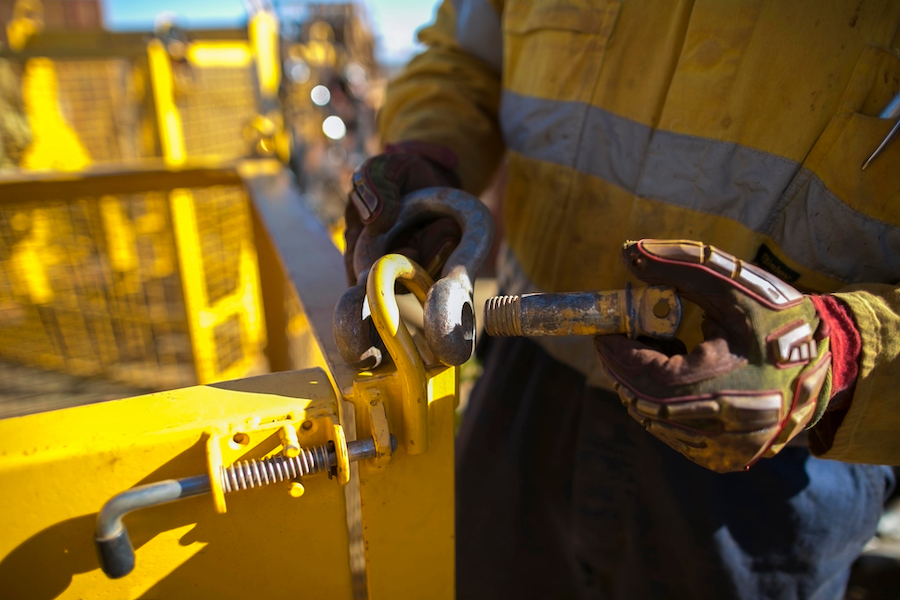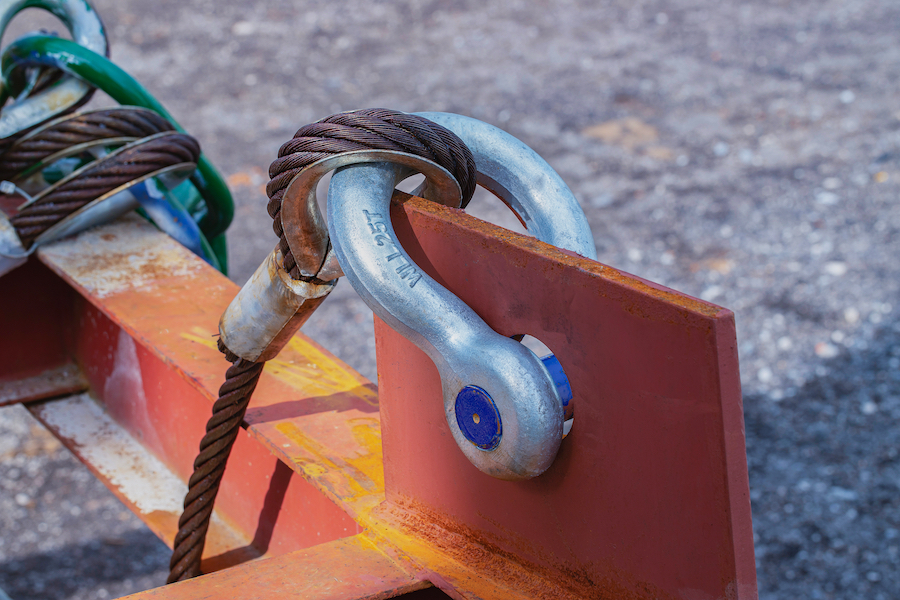
View the complete article here.
Shackles are an essential part of lifting and rigging. They come in a variety of sizes and types, each with its own specific purpose.
But no matter what type of shackle you’re using, there are certain rules you must always follow to ensure safety.
Let’s take a closer look.
What is the Proper Way to Use a Shackle?
A shackle is a type of hardware used for connecting two pieces of equipment or material. It typically consists of a metal loop with a pin or screw that can be passed through it. Shackles are often used in construction and other industrial applications, as they provide a strong and secure connection.
Again, shackles come in many different sizes and types, so it is important to select the right shackle for the job at hand and to read manufacturer instructions before starting any job.
For example, a chain shackle should not be used to connect two pieces of rope, as the sharp edges could damage the rope. Similarly, a pin shackle should not be used in an application where high loads are expected, as the pin could shear off under strain. selecting the proper shackle will help to ensure a safe and successful rigging job.
Once the proper shackle has been selected, it is important to attach it correctly. Most shackles have a pin or bolt that must be inserted in order to secure the connection. Make sure that the pin is fully inserted and that any locking mechanisms are engaged before applying any load to the shackle.
When attaching a shackle to a piece of equipment, it is important to use a secure point such as a D-ring or pad eye. Avoid attaching shackles to webbing or other materials that could tear or stretch under load.
What Information Should Shackles Have On Them?
Before using your shackles, always check for basic information, which should be stamped on the side of the shackle itself.
Shackles should be marked with the manufacturer’s name, the size and type of shackle, the serial number, the working load limit, and the date of manufacture.
This information is essential for ensuring that the shackle is used correctly and that it is not overloaded. In addition, this information can be helpful in the event of an accident.

16 Rules to Remember When Using Shackles
Here are some general tips to remember when using shackles in any setting.
1. Safety First
When it comes to using shackles, safety should always be your top priority. That means never exceeding the working load limit and avoiding shock loading.
Each shackle has a working load limit (WLL), which is the maximum weight that the shackle can safely support. Do not try to lift more than the WLL, as this could cause the shackle to fail and injure anyone nearby.
You should also inspect the shackle before each use, and if necessary, use spacers to prevent the shackle from being loaded at an angle. Additionally, keep in mind that shackles can be damaged by exposure to extreme temperatures, so avoid using them in excessively hot or cold environments.
Many of the rules we’ll go through below are designed with regard to safety, while others are more for productivity’s sake or for the longevity of your shackles. No matter what, though, it’s important that you keep operator safety – particularly the few tips above – in mind when using your shackles.
2. Inspect Before Use
Take the time to give your shackles a quick once-over before each use, looking for any signs of wear or damage. If you spot anything, don’t use the shackle until it has been repaired or replaced. Likewise, if you’re not sure whether a shackle is safe to use, err on the side of caution and don’t use it.
3. Use the Right Shackle for the Job
Not all shackles are created equal. Some are designed for light loads while others can handle much heavier weights. Be sure to select the right shackle for the job at hand, and don’t overload it beyond its capacity. If you’re not sure which shackle to use, consult a rigging specialist or ask your supervisor for guidance.
4. Avoid Sudden Acceleration or Deceleration
One rule to remember when using shackles is to avoid sudden acceleration or deceleration.
Sudden changes in speed can put undue stress on the shackles and cause them to break. In addition, when accelerating or decelerating quickly, the load that the shackles are supporting can shift, leading to a loss of control and potential injury.
For these reasons, it is always best to use a gradual, controlled acceleration and deceleration when working with shackles. This will help to ensure the safety of both the operator and the load.
5. Connect Multiple Shackles to the Body, Not the Pin
When using shackles, it is important to connect multiple shackles to the body, not the pin. This will distribute the load more evenly and prevent the shackle from being overloaded.
If the shackle body fails, the load will be transferred to the pin, which is much weaker. This could cause the pin to fail, resulting in a drop.
Connecting multiple shackles to the body will prevent the shackle from being pulled out of alignment, which can also cause failure.
6. Always Make Sure Connections are Correct
One mistake that people often make when using shackles is attaching a point loading pin to the pin, instead of the bow. This can put too much stress on the pin, causing it to break or bend.
Additionally, always make sure that the connections between the shackle and the load are secure and correct. Improperly connected shackles can come loose and cause accidents or damage your equipment.

7. Don’t Force or Wedge a Shackle That is Too Small Into Position
If a shackle is too small for the load, do not force it into position or wedge it into place with another object.
Doing so can damage the shackle and create a hazardous situation. Instead, choose a shackle that is the proper size for the load and has a Working Load Limit that exceeds the weight of the load.
8. Don’t Let Them Come Into Contact With Moving Parts if the Pin Can Come Unscrewed
One of the most important safety rules is to never let shackles come into contact with moving parts. If the pin can come unscrewed, it presents a serious hazard.
9. Don’t Side Load a Round Pin Shackle
One of the most important things to remember when using shackles is not to side load a round pin shackle. This means applying force to the shackle from the side, rather than along the axis of the pin.
When a round pin shackle is side loaded, it can cause the pin to bend or break, resulting in the loss of whatever was being held by the shackle. In some cases, this can even lead to serious injury.
D shaped shackles (like chain or long reach shackles) also should not be sidleoaded – more on this below.
10. Attach Sling’s Legs to Bow Instead of Pins
When you’re using shackles, always attach the sling’s legs to the bow instead of the pins. It might seem like it wouldn’t make a big difference, but attaching the legs to the pins can weaken and damage the sling over time. If you don’t properly connect the components, you risk damaging the sling beyond repair. With enough improper attachments, you could even put your workers in danger.
11. Connect Bow to Bow or Bow to Pin When Point Loading
When using shackles, connecting the pin to the pin will create a point load. This point load can be transferred through the shackle, and into the sling legs, which are not designed to handle that level of stress.
However, by attaching multiple sling legs to the bow, the point load is distributed across a larger area, making it much less likely to damage the sling. In addition, by attaching legs to the bow, rather than the pin, you can also avoid accidentally damaging or weakening the shackle itself.
12. Don’t Side Load Shackles in a D Shape
When using shackles, it’s important to keep in mind how they are best utilized. Chain and long-reach shackles work best when applied in-line with tension. This means that the center lines on both the load and the shackle should be lined up.
Bolt type anchor shackles can also withstand a side load, but for this application it is best to check the rating chart.

13. If Using Wire Rope, Make Sure the Shackle is Not Smaller Than the Wire Rope Diameter
When using wire rope, make sure the shackle is not smaller than the wire rope diameter. This will help to prevent the shackle from slipping off or breaking under tension.
If possible, use a shackle that is slightly larger than the wire rope, as this will provide an additional safety margin.
14. Remember the Rated WLL Will Reduce When Sideloading a Shackle With a Single Sling
Shackles are a vital part of any rigging system, but it’s important to remember that their capacity will be reduced when sideloading with a single sling. The reduction in capacity is due to the fact that, when sideloading, there is an increased risk of the shackle becoming overloaded and failing.
Only anchor shackles 3/6″ to 3″ may be sideloaded, and chain or long reach shackles should not be sideloaded.
15. Synthetic Slings? Make Sure the Shackle is Large Enough to Avoid Binding
Using shackles with synthetic slings is a great way to secure your load.
However, it’s important to make sure that the shackle is large enough to avoid binding. If the shackle is too small, it can cause the sling to rub against itself, which can wear down the material and eventually cause it to fail.
Additionally, if the sling is under tension, a small shackle can cause the sling to slip, which could lead to an accident.
16. If Shackles Will Remain in Place Permanently, Use Bolt Nut Cotter Anchor Style Shackles
When deciding which type of shackle to use for a project, it is important to consider how long the shackle will need to stay in the same place. For semi-permanent applications or for situations where the shackle will be holding a load for a long period, bolt nut cotter anchor-style shackles are the best option.
These shackles are designed for strength and durability, and the cotter pin helps to ensure that the shackle will not come loose. If you have to use screw pin shackles to hold a load for a long period of time, you may want to tie off or mouse the pin with wire to the shackle body.
Final Thoughts
Shackles play an important role in lifting and rigging, but they can also be dangerous if they’re not used properly.
By following these simple tips, you can help ensure a safe working environment for yourself and your coworkers.
View the complete article here.
What information should be checked on shackles before use?
Before using shackles, check for manufacturer information stamped on the side, including the name, shackle size and type, serial number, working load limit, and date of manufacture.
How can I ensure safety when using shackles in lifting and rigging?
Prioritize safety by adhering to the shackle's working load limit, conducting regular inspections for wear or damage, selecting the right shackle for the specific job, and avoiding sudden acceleration or deceleration during operations.












































